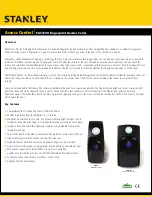
TST-020 PT-AIR
– REV. 2017-246
Page 13 of 14
The tilt control valve consists of an incoming airline (
13A
),
two vent plugs (
13B
) and two feed lines (
13C
).
When the handle is in the center position, all the ports are
closed.
A leak is indicated when the handle is in the center and air
is flowing from the vent ports or from the ports to the feed
lines of the actuator.
Begin by checking the ports with the vent plugs (
13B
).
With the air supply valve open, tilt the lifter to the position
where it drifts and lightly spray the vent plugs with a soap
and water solution. Bubbles indicate a leak.
If there is no indication of a leak at the vent plugs, the
feed lines to the actuator should be checked.
To check the actuator feed line ports:
Disconnect the air supply from the lifter.
Disconnect the hoses from the tilt control
valve that connect to the flow valves of the
actuator.
Reconnect the air supply to the lifter.
Note: Do not engage the handle of the tilt valve
assembly with the hoses removed.
Wrap a smooth towel (
14A
) tight over the end of
either of the ports that connect to the actuator.
Spray the area covering the open port with a soap
and water solution. Bubbles indicate a leak. If there is no leak when the first port is tested, test the
second port.
If there is any indication of a leak through either port of the tilt control valve, replace the valve.
If neither the flow valves nor the tilt control valve leak, the issue is likely to be the internal seals of
the actuator.
Contact Wood’s Powr-Grip for additional information.
FIGURE 13
13A
13B
13C
FIGURE 14
14A


































